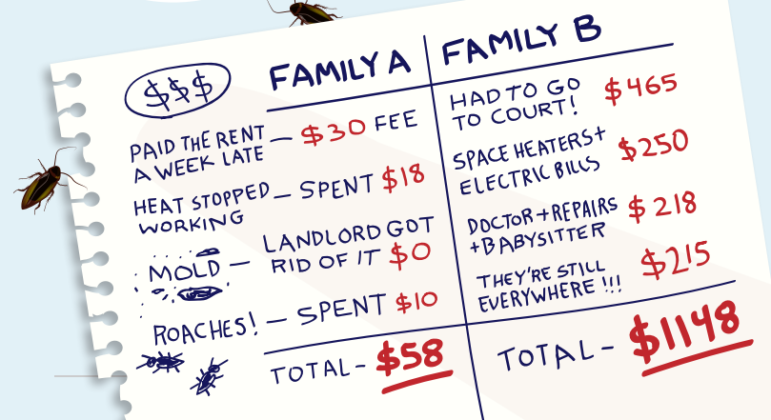
RPA
An illustration from the RPA report sizes up the impact of a normal landlord versus one of the bad ones.
Tuesday’s news brought word of another lousy landlord. The state attorney general was alleging that the owners of a 10-unit Queens building had for years taken tax breaks that apply to rent-regulated housing without actually offering tenants those protections, allowing the landlords to pocket nearly half a million dollars in property tax savings. It was just the latest in dozens of prosecutions and settlements that the state AG has announced involving the people who own other New Yorkers’ homes.
Like all crimes involving a class of people—felonious undocumented immigrants, predatory Catholic priests, abusive or corrupt police officers, terroristic Muslims—it is always tempting to extrapolate from isolated landlord wrongdoers into a broader indictment of the entire group. But, as is always the case, it is factually risky to do so.
According to research out Wednesday from the Regional Plan Association, what amounts to a handful of bad landlords is responsible for a vast amount of the city’s poor housing and eviction cases. And since those problems impose huge costs on the city in the form of homeless shelter costs and code-enforcement expenses, a handful of New York property owners are indirectly sticking their hand into the pocket of each New Yorker.
RPA estimates that “of the 763,276 buildings with residential units in NYC, less than 2 percent are managed by bad landlords,” which the Association defines as having a building with more than 10 housing-code violations, having had at least two eviction cases in housing court between 2013 and mid-2015 and having eviction proceedings involving 30 percent of their units.
But while bad landlords own only one in 50 buildings, their buildings tend to be large—so about one in five New Yorkers lives in one of those buildings. But even when one takes that into account, bad landlords punch about their weight: They account for nearly half the eviction proceedings and half of the actual evictions that occur in the city. Nor are those risks borne evenly. A third of the Bronx lives in bad landlord buildings. And those properties are home to disproportionate numbers of kids, people of color, people with disabilities and low-income New Yorkers.
When RPA tallies up the public spending necessitated by those bad buildings, it concludes that $307 million in annual costs can be laid on their doorsteps. But those are just the fiscal costs. The human impact is steeper, the report contends:
Living under such housing conditions can have many impacts on people’s health, something that can be particularly harmful for people already dealing with the stresses of poverty or to vulnerable populations such as children, seniors and people with disabilities. Pest infestations, for example, can trigger allergies; and lack of heat can lead to hypothermia. The stress from dealing with these challenges alone can lead to health problems. Building on comprehensive studies estimating the health and economic impacts of lead and mold exposure, we very conservatively estimate that:
–339 children under 5 were exposed to lead due to bad landlords, leading to health problems such as brain damage and costing $680,000 dollars in medical and special education costs.
–413 people with Allergic Rhinitis, 284 people with Asthma due to mold exposure, leading to $2.6 million dollars in total economic costs.
The idea isn’t that life is idyllic in housing owned by other landlords: There are still stresses and problems, but they get dealt with in a manner that avoids needless delay, human suffering or financial cost. Comparing two imaginary apartments—one owned by a decent landlord and the other by an indecent one—that both suffer the very typical problems of late rent, bad heat, bathroom mold and pesky vermin, RPA maps out how one family can go out of pocket $58 to deal with the problems and the other can shell out more than $1,100 to cope.
Let’s face it: The beefs between tenants and property owners are not solely about housing conditions and the possibility of eviction. Especially in the city’s hyper-charged real-estate market, the fundamental facts of their respective roles—that one owns the home of the other—make for inevitable conflict.
Sometimes that tension manifests itself in lousy conditions and evictions: Some landlords have been known to try to get rent-regulated tenants out in order to boost rents. But often, the problem is simpler. It’s the mounting gap between the profits landlords can get and the rents working-class New Yorkers can afford.
In other words, “bad landlords” (however one defines that term) aren’t the only problem facing New York City tenants. But separating the bad landlords from decent ones who simply have little motivation for keeping housing affordable might be a step toward figuring out whether an inclusive city and a private real-estate market can ever co-exist again.









One thought on “Report: ‘Bad Landlords’ are Few in Number but Destructive in Impact”
I need advice on where to start on my landlord abusive just collecting for 30 yrs no good maintenance doesn’t check up on building until code enforcement contacts get for visual roof repairs. This has caused me years of health issues and I’m just finding out.
Please direct me to someone that will help me m. I’m in California